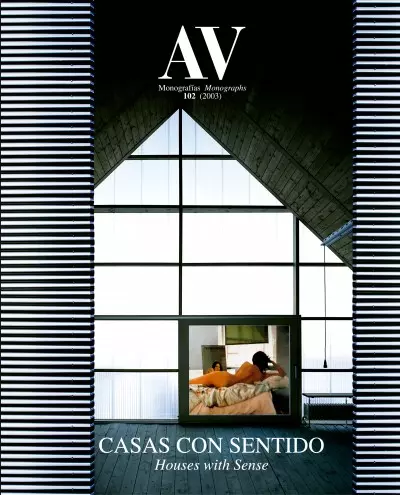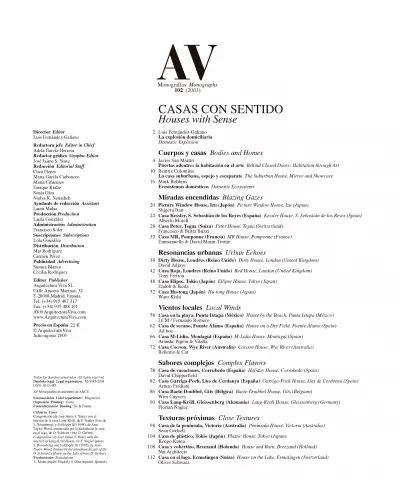CASAS CON SENTIDO
Luis Fernández-Galiano
La explosión domiciliaria
Domestic Explosion
Cuerpos y casas Bodies and Homes
Javier San Martín
Puertas adentro: la habitación en el arte Behind Closed Doors: Habitation through Art
Beatriz Colomina
La casa suburbana, espejo y escaparate The Suburban House, Mirror and Showcase
Mark Robbins
Ecosistemas domésticos Domestic Ecosystems
Miradas encendidas Blazing Gazes
Picture Window House, Izu (Japón) Picture Window House, Izu (Japan)
Shigeru Ban
Casa Kessler, S. Sebastián de los Reyes (España) Kessler House, S. Sebastián de los Reyes (Spain)
Alberto Morell
Casa Peter, Tegna (Suiza) Peter House, Tegna (Switzerland)
Francesco & Britta Buzzi
Casa MR, Pomponne (Francia) MR House, Pomponne (France)
Emmanuelle & David Marin-Trottin
Resonancias urbanas Urban Echoes
Dirty House, Londres (Reino Unido) Dirty House, London (United Kingdom)
David Adjaye
Casa Roja, Londres (Reino Unido) Red House, London (United Kingdom)
Tony Fretton
Casa Elipse, Tokio (Japón) Ellipse House, Tokyo (Japan)
Endoh & Ikeda
Casa Hu-tong (Japón) Hu-tong House (Japan)
Waro Kishi
Vientos locales Local Winds
Casa en la playa, Punta Ixtapa (México) House by the Beach, Punta Ixtapa (México)
LCM / Fernando Romero
Casa de secano, Fuente Álamo (España) House on a Dry Field, Fuente Álamo (Spain)
Ad hoc
Casa M-Lidia, Montagut (España) M-Lidia House, Montagut (Spain)
Aranda, Pigem & Vilalta
Casa Cocoon, Wye River (Australia) Cocoon House, Wye River (Australia)
Bellemo & Cat
Sabores complejos Complex Flavors
Casa de vacaciones, Corrubedo (España) Holiday House, Corrubedo (Spain)
David Chipperfield
Casa Garriga-Poch, Lles de Cerdanya (España) Garriga-Poch House, Lles de Cerdanya (Spain)
Arturo Frediani
Casa Baete-Doubbel, Gits (Bélgica) Baete-Doubbel House, Gits (Belgium)
Wim Cuyvers
Casa Lang-Kröll, Gleissenberg (Alemania) Lang-Kröll House, Gleissenberg (Germany)
Florian Nagler
Texturas próximas Close Textures
Casa de la península, Victoria (Australia) Peninsula House, Victoria (Australia)
Sean Godsell
Casa de plástico, Tokio (Japón) Plastic House, Tokyo (Japan)
Kengo Kuma
Casa y cobertizo, Breezand (Holanda) House and Barn, Breezand (Holland)
Nat Architects
Casa en el lago, Ermatingen (Suiza) House on the Lake, Ermatingen (Switzerland)
Oliver Schwarz
Luis Fernández-Galiano
Domestic Explosion
We live explosive times. On the one hand, the residential boom has acquired a new economic and urban protagonism: the real estate bubble is the driving force of growth, and the formless extension of construction the main feature of contemporary planning. On the other hand, aggressive detonation is the key weapon in the essential conflict of our era: Palestinian martyrs turn themselves into human bombs, while the Israeli army uses the demolition of dwellings with dynamite as a regular war weapon. The domiciliar explosion is at once the uncontrolled multiplication of the residential fabric in the West and its controlled destruction on the line of fracture with the Muslim other. In Zabriskie Point, Antonioni showed in slow motion the explosion of a house into an expansive sphere of fragments: a simultaneous symbol of the urbanistic bubble that fills landscapes with repetitive rubble and of the punitive demolition that blows houses up.
We like to imagine the house as a warm nest, woven around to protect us like the cocoon shelters the worm, and in which to fearlessly surrender to the pleasures of the senses: locked in with a single toy, or else shut out in a private place cluttered with familiar objects. In this way, we have rehearsed here a haphazard order that brings together our signature houses around the convention of the perceptive organs: the bright light of horizons and lamps, the ear attentive to the noise of traffic or to the ringing of bells, the perfume of moving air, the mixed cold flavors of food, the texture of materials in the dark softness of beds. However, this enumeration of the senses is drained of meaning when we expose it to the elements of repetition and risk, and both the anomy of sprawl and the physical insecurity of the border habitation draws a solitary and soulless landscape, one that is built around the resounding hole of a spiritual void.
Houses with sense and consented devastation: such seems to be the oxymoronic panorama of the present city. We feign living while we are surviving, and our inability to shape the territory is similar to our failure in the conciliation of conflict. Failing in geography and failing in history, the inhabitants of this fragile planet prefer to ignore the cracks that cover its tattered skin while we sink into the narcotic laudanum of the self-absorbed dwelling. But the morbid beauty of the house becomes obscene when it is shielded from the collapse of the world, closing its eyes to violence, turning a deaf ear to offense, refusing to follow the scent of abuse, concealing the persistent taste of pain and escaping the abrasive contact with misery. The designer houses digs out an autistic niche in space and time, an ephemeral and sweet scenario of daily life momentarily suspended: a private oasis in the public desert.








